
Welcome to your digital source for knitting projects, yarn know-how, exclusive fiber stories, and more. The Farm & Fiber Knits Library includes patterns, technique articles, and resources to deepen your craft.
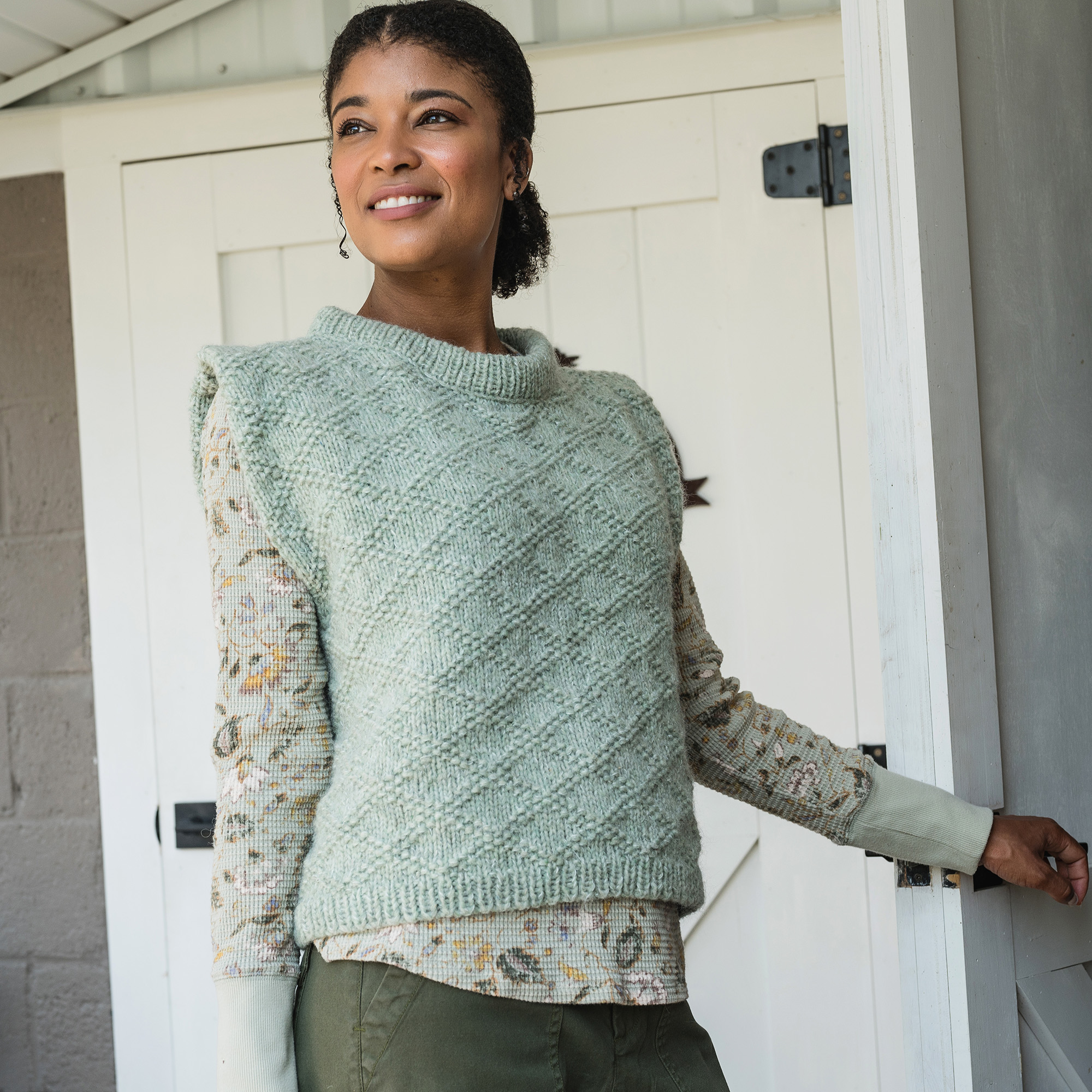
This slipover was designed to show off the King Charles Brocade, a beautiful textured stitch pattern. This lovely diamond brocade is a joy to knit, as every round keeps you engaged without being too difficult—no mindless stockinette here, but nothing more complicated than knits and purls.
The slipover is meant to be oversized, able to fit over another knit or a long-sleeve shirt in the winter, but also able to be worn on its own or over a short-sleeve T-shirt in the late spring or early autumn. It’s a perfect year round layer to have on hand for whatever the weather throws at you.
MATERIALS
Yarn Wooldreamers Manchelopis (100% Manchega wool; 251 yd [230 m]/3½ oz [100 g]; DK); Verde, 3 (3, 3, 4, 4) (4, 5, 5, 5) wheels. Rowan Kidsilk Haze (70% mohair, 30% silk; 229 yd [209 m]/25 g; lace); #693 Mint, 4 (4, 4, 5, 5) (5, 6, 6, 6) balls.
Needles Size 10½ (6.5 mm) 24" circular (cir) for body and size 9 (5.5 mm) 16" cir for collar. Adjust needle size if necessary to obtain the correct gauge.
Notions Markers (m); row counter; stitch holder or spare cir needle; tapestry needle; J-10/6 mm crochet hook.
Gauge 15 sts and 24 rows = about 4" (10 cm) in pattern, blocked.
Finished Size 41½ (45, 51, 54½, 57½) (61, 67, 70½, 73½)" (104 [112.5, 127.5, 136.5, 144] [152.5, 167.5, 176.5, 184] cm) bust circumference. Shown in size 41½" with 5½" (14 cm) ease.
Juliette Pécault is a knitwear designer focused on knitting with intention. She encourages knitters to embrace slow making and build a sustainable, one-of-a-kind wardrobe with modern, wearable designs that highlight the benefits of natural materials and non-superwash wools.
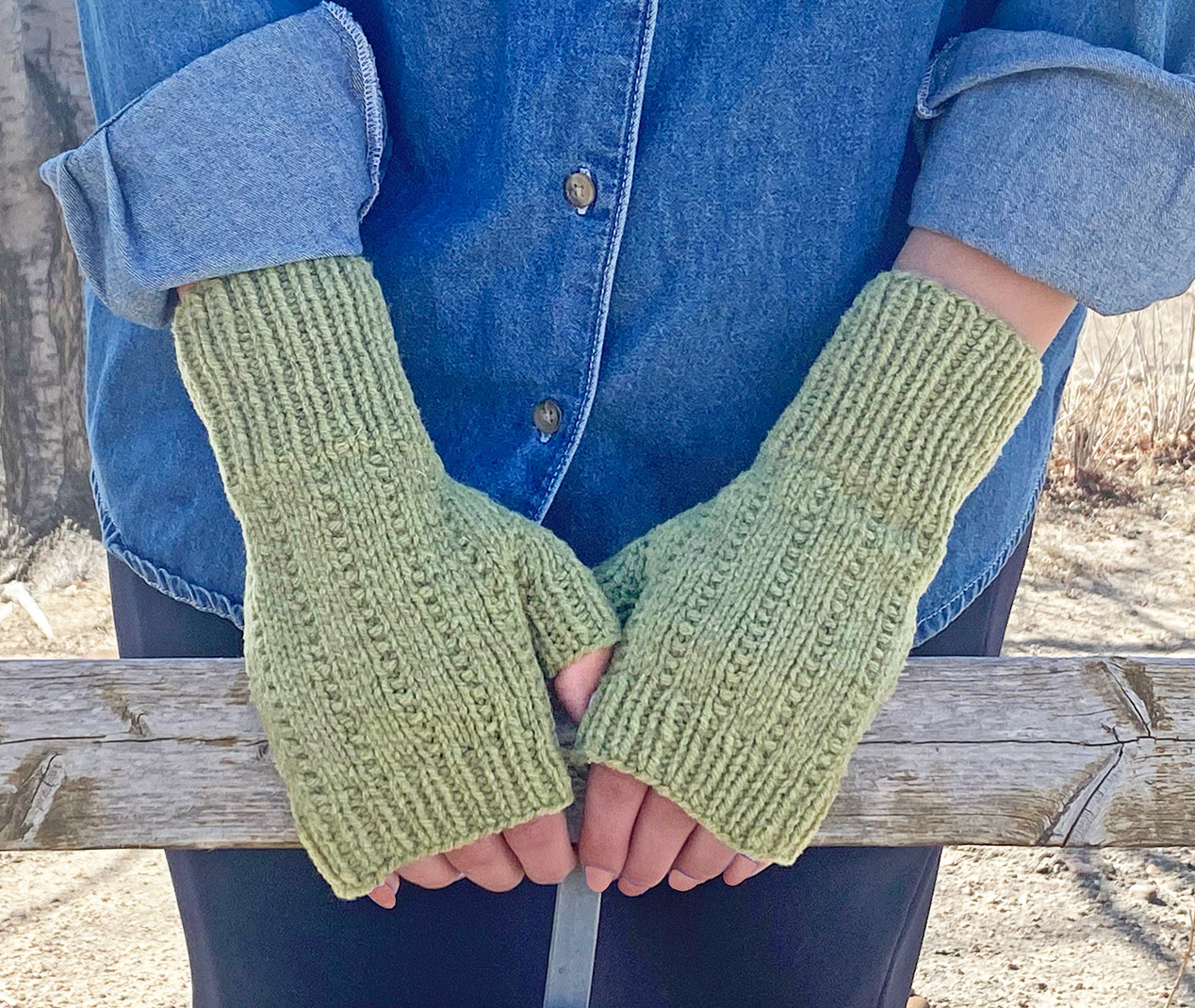
This isn’t so much a pattern as it is a recipe for making simple fingerless mitts in any size using whatever yarn you please. It relies on a simple set of proportions that govern the shaping of a handcovering. So, unlike most patterns, there is no specific finished size, gauge, or yarn, and there is no recommended needle size. Starting with a swatch, you decide what fabric density and feel you want, and then you follow the worksheet to create your mitts!
These mitts are a beautiful opportunity to showcase a special skein of yarn. Use that skein of handspun you were given by a friend, or that souvenir skein of small-batch yarn you picked up at a fiber festival. Feel free to play with stripes of color in your mitts. Fingerless mitts can be a great stash-buster if you have small amounts of yarn left over from other projects.
The instructions for the mitts starts with a worksheet, which is included in the Wanderlust Mitts pattern. You knit a swatch, take a few measurments, and fill in the blanks. Sandi's simple process has you casting on in no time!
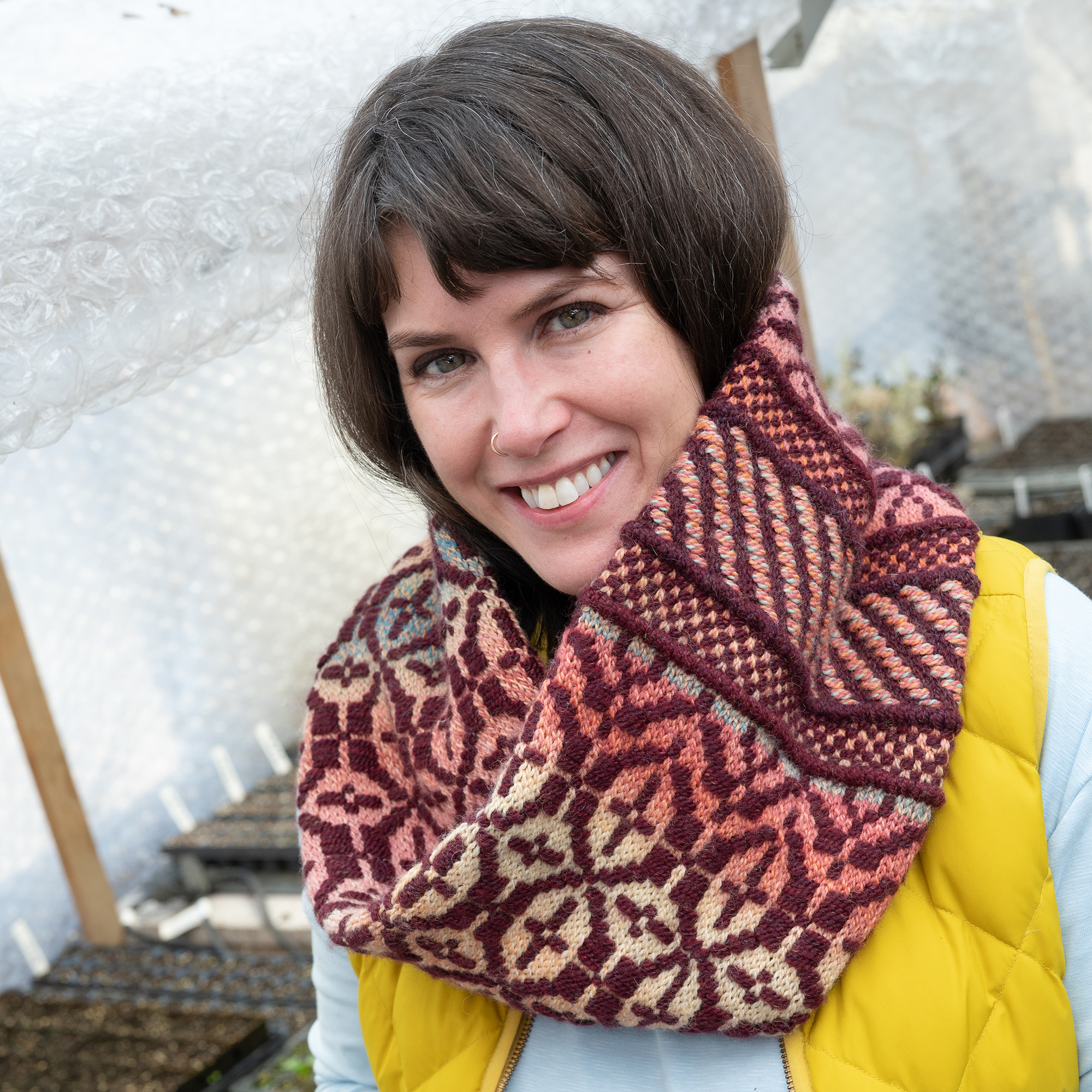
MATERIALS
Yarn Feederbrook Farm Entropy DK (100% BFL Wool; 260 yd [238 m]/100 g); Solute (MC), 2 skeins. Feederbrook Farm Equilibrium DK (96% Merino, 4% Glitter; 260 yds [238 m]/100 g); Burgundy (CC), 2 skeins.
Needles Size 5 (3.75 mm): 16" (40 cm) circular (cir); size 7 (4.5 mm): 16–20" (40–50 cm) cir. Adjust needle size if necessary to obtain the correct gauge.
Notions Markers (m), 6 plus 1 contrasting BOR; 5 locking stitch markers; size G/6 (4 mm) crochet hook; point protectors; tapestry needle.
Gauge 21 sts and 24 rnds = 4" (10 cm) on Inlay colorwork in the round on larger needle, lightly blocked.
Finished Size 31½" (80 cm) long before grafting. After grafting 16" (40.5 cm) circumference and 8" (20 cm) tall.
Additional Resources
The pattern includes links to several additional video tutorials:
How to Make Center-Pull Yarn Balls (the Easy Way): YouTube.com
Crochet Provisional Cast-on: LT.Media/Crochet-CO
How to Knit the Wk1 Stitch: LT.Media/Clover-Wk1
Picking Up a Provisional Cast-On & Prepping for Grafting: LT.Media/Clover-Seaming
Rows of PurL, located in beautiful Chester, New Jersey, specializes in handmade crafts from a variety of available yarns. Owned and operated by Jenny Monteleone, the store places a particular emphasis on developing the individual growth of an artist and providing excellent customer service. Whether you knit, crochet, are a fiber artist of any sort or aspire to be any of the above, there is something for everyone!

This oversized vest is reminiscent of vintage, thrifted finds and features simple pullover styling designed to pair with your favorite button-up shirts, dresses, and skirts.
The v-neck is flattering and classic, and the body of the vest is highlighted in an easy diamond cable pattern. The diamonds form frames for wool embroidery that celebrates a variety of spring and summer flowers inspired by my garden.
MATERIALS
Yarn Harrisville Designs Highland (100% wool; 200 yd [183 m]/100 g; worsted); Sand (MC) 3 (3, 4, 4, 5) (5, 5, 6, 7) hanks. Embroidery: Harrisville Designs Shetland (100% wool; 217 yd [198 m]/50 g; fingering); various colors, 10 yds each.
Needles Size 9 (5.5 mm): 40–60" circular (cir). Size 8 (5 mm): 16" cir. Adjust needle size if necessary to obtain the correct gauge.
Notions Removable markers (m); stitch holder or scrap yarn; cable needle (cn) optional; tapestry needle; large-eye embroidery needle; wash-away embroidery stabilizer; sewing thread and needle for basting stabilizer.
Gauge 15 sts and 23 rnds = 4" (10 cm) in Diamond Cable Patt on larger needles.
Finished Size 44¾ (48, 51¼, 57½, 60¾) (64, 67¼, 70½, 76¾)" (114 [122, 130, 146.5, 154.5] [162.5, 171, 179, 195 cm]) chest circumference; meant to fit with 8–10" (20–25 cm) positive ease. Vest shown measures 44¾", worn with 10" positive ease.
Hannah Thiessen Howard is the writer of Slow Knitting and Seasonal Slow Knitting, books dedicated to celebrating the wholeness of satisfaction when working with yarns that have stories behind their fibers. She is also the owner and editor of By Hand Serial, a publication that explores travel destinations through the eyes of local crafters. When not working her day job managing communications for an angel investment fund, Hannah loves sharing her knowledge and experience with the fiber industry, supporting small businesses, and uplifting the work of other creatives. She watercolor paints, designs, and writes in her home studio in Tennessee with her husband and extremely pampered cats.
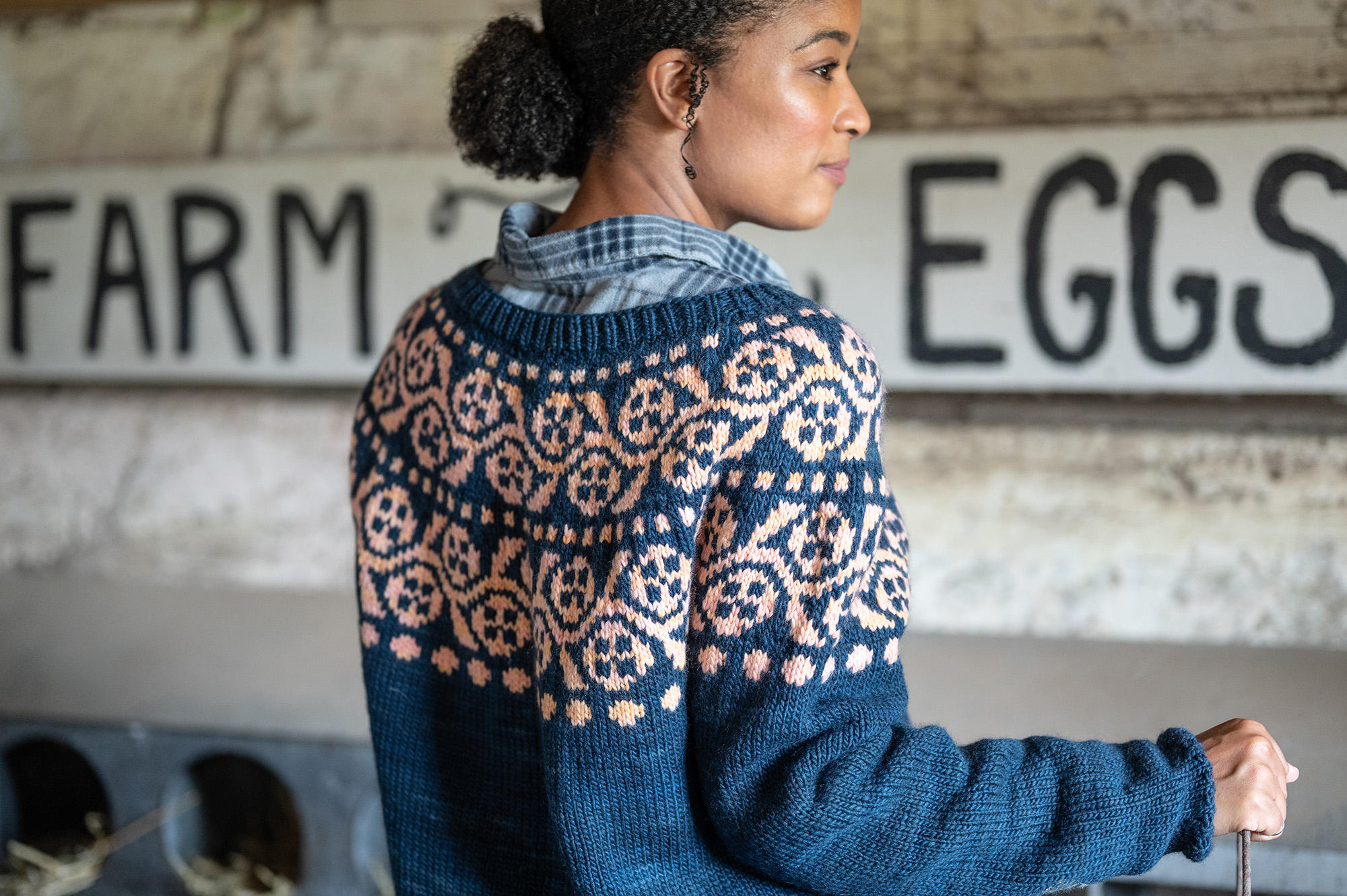
Inspired by her garden’s clematis vine, Deborah Newton designed this pullover sweater to have a slightly oversized fit that’s comfortable to wear and easy to layer. The subtle color shifts of the soft, lofty singles yarn add depth to the abstract floral pattern.
MATERIALS Yarn Manos del Uruguay Maxima (100% wool; 219 yd [200 m]/3½ oz [100 g]; worsted weight; distributed by Fairmount Fibers); #M2468 Galaxy Blue (MC), 5 (6, 6, 7, 7) (8, 9, 9, 10) skeins; #M2163 Apricot (CC), 1 (1, 1, 1, 1) (2, 2, 2, 2) skein(s). Note:Add 1 skein MC for a longer body or sleeves.
Needles Sizes 8 (5 mm) and 9 (5.5 mm): 16" and 24" circular (cir) and sets of double-pointed needles (dpns). Adjust needle size if necessary to obtain gauge.
Notions Markers (m), 4; smooth yarn in contrasting color for stitch holder; tapestry needle.
Gauge 18 sts and 28 rnds = 4" (10 cm) in St st on larger needle. 20 sts and 22 rnds = 4" (10 cm) in Yoke Charted patterns on larger needle.
Finished size 36½ (40, 44½, 48, 52½) (56, 60½, 64, 68½)" (92.5 [101.5, 113, 122, 133.5] [142, 153.5, 162.5, 174] cm) bust circumference. Shown in size 44½", with 8½" (21.5 cm) ease.
Deborah Newton teaches and designs knitwear in her native city of Providence, Rhode Island. She is the author of Finishing School: A Master Class for Knitters and Good Measure: Knit a Perfect Fit Every Time. Find her online at deborahnewtonknits.com, on Ravelry as deborahnewton, and on Instagram @deborahnewtonknits.

I love the ease of mosaic knitting. Using only one color at a time, you can create complex geometric colorwork with only slipped stitches and knit stitches. But mosaic patterns don’t usually lend themselves to working in isolated panels.
Knitting these mitts from side to side allows you to keep the palms and thumbs plain and simple, while showing off your mosaic patterning on the back of the hand. You’ll use a provisional cast-on to begin at the pinky-side of the hand and work back and forth in rows, shaping the thumb with German short-rows. The final row of knitting is grafted to the cast-on stitches for a seamless result.
MATERIALS
Yarn Bare Naked Wools by Knitspot Targhee Tango Sport (100% Targhee wool; 400 yd/4 oz; sportweight); Nuevo (MC) and Apilado (CC), 1 skein each.
Needles Size 5 (3.75 mm). Adjust needle size if necessary to obtain the correct gauge.
Notions Markers (m); stitch holders or waste yarn; tapestry nedle.
Gauge 24 sts and 32 rows = about 4" (10 cm) in St st; 22 sts and 44 rows = about 4" (10 cm) in garter st, blocked.
Finished Size 7 (7½, 8)" (18 [19, 20.5] cm) hand circumference and 7¼ (8¼, 9)" (18.5 [21, 23] cm) long. Shown in size 7½" (19 cm).
Sandi Rosner (she/her) learned to knit in the late 1970s from the instructions in the back of a magazine. She now works as a freelance designer, technical editor, writer, and teacher. When Sandi isn’t knitting, she usually has her nose in a book. Find more of Sandi’s work at sandirosner.substack.com.
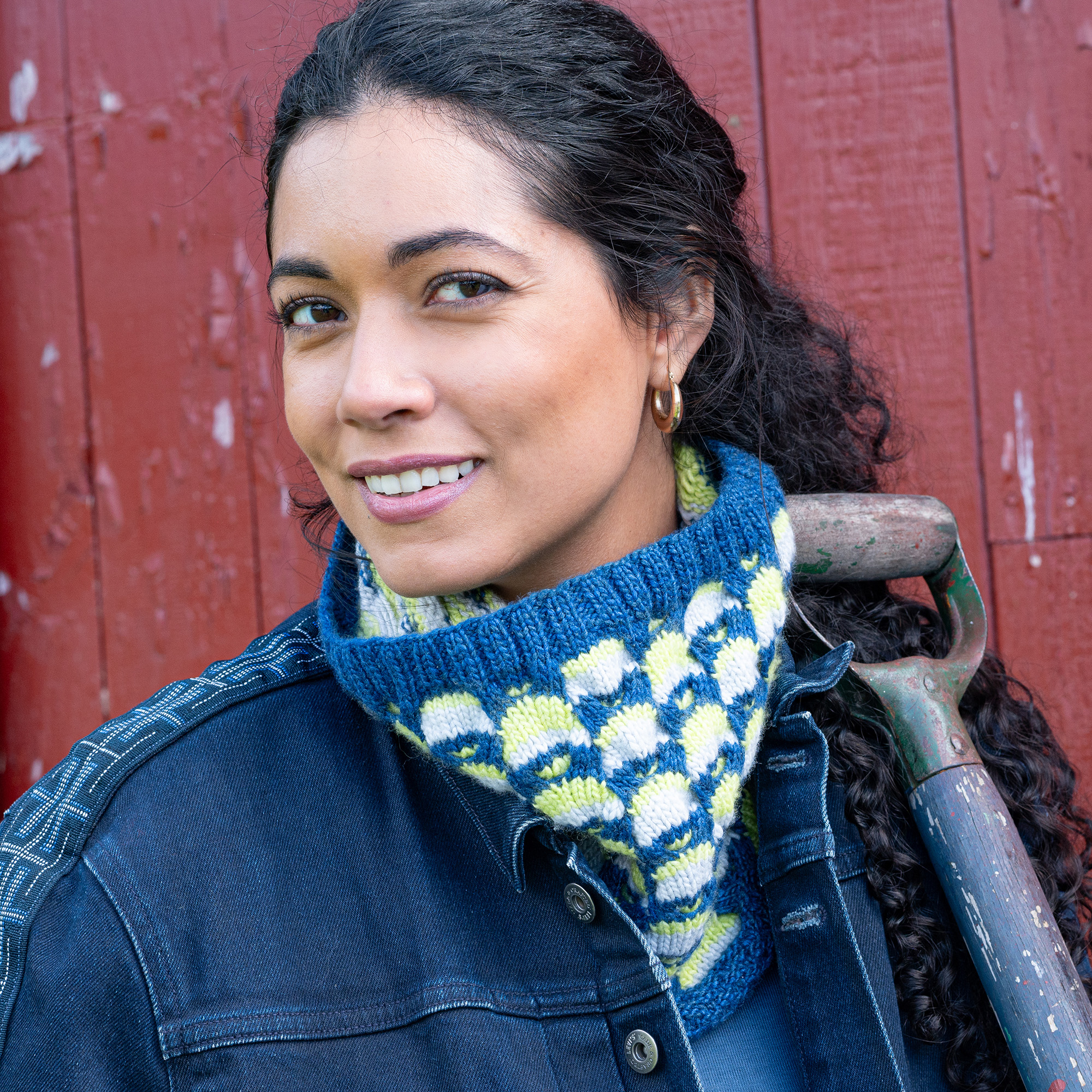
No matter what you will face in the course of a day, wearing a soft, luxurious cowl first thing in the morning can make you feel dreamy. Meet the day with this modern cowl, which uses a three-color sequence and slip-stitch pattern in a continuous flow. Knitted in one piece in the round from bottom up with some simple shaping, this cowl is fun to make and very easy to style.
MATERIALS
Yarn Manos del Uruguay Silk Blend DK (70% Merino, 30% silk; 150 yd [135 m]/50 g; DK weight), #SB3217 Dark Wash (MC), #SB3218 Silver (CC1), and #SB3079 Chartreuse (CC2), 1 skein each.
Needles Size 5 (3.75 mm) and size 4 (3.5 mm): 24" (60 cm) circular (cir). Optional: Size 1 (2.25 mm) one double-pointed (dpn) for welt. Adjust needle size if necessary to obtain the correct gauge.
Notions Marker (m); cable needle (cn); tapestry needle.
Gauge 28 sts and 50 rnds = about 4" (10 cm) in Large Dunes patt using larger needle, blocked.
Finished Size 21" (53 cm) neck circumference, 27" (68.5 cm) hem circumference, and 10" (25.5 cm) tall, after blocking.
Faina Goberstein is a knitwear designer, author, and knitting instructor who teaches live and online. Faina is the author of Fresh Slipstitch and the co-author of The Art of Slip Stitch and The Art of Seamless Knitting. Her designs have appeared in magazines such as Rowan, Vogue Knitting, Interweave Knits, and Cast-On and in numerous books. She is based in northern California. Find her online at fgdesignsknits.com or on Instagram at @faina.go.
No matter what you will face in the course of a day, wearing a soft, luxurious cowl first thing in the morning can make you feel dreamy. Meet the day with this modern cowl, which uses a three-color sequence and slip-stitch pattern in a continuous flow. Knitted in one piece in the round from bottom up with some simple shaping, this cowl is fun to make and very easy to style.
MATERIALS
Yarn Manos del Uruguay Silk Blend DK (70% Merino, 30% silk; 150 yd [135 m]/50 g; DK weight), #SB3217 Dark Wash (MC), #SB3218 Silver (CC1), and #SB3079 Chartreuse (CC2), 1 skein each.
Needles Size 5 (3.75 mm) and size 4 (3.5 mm): 24" (60 cm) circular (cir). Optional: Size 1 (2.25 mm) one double-pointed (dpn) for welt. Adjust needle size if necessary to obtain the correct gauge.
Notions Marker (m); cable needle (cn); tapestry needle.
Gauge 28 sts and 50 rnds = about 4" (10 cm) in Large Dunes patt using larger needle, blocked.
Finished Size 21" (53 cm) neck circumference, 27" (68.5 cm) hem circumference, and 10" (25.5 cm) tall, after blocking.
Faina Goberstein is a knitwear designer, author, and knitting instructor who teaches live and online. Faina is the author of Fresh Slipstitch and the co-author of The Art of Slip Stitch and The Art of Seamless Knitting. Her designs have appeared in magazines such as Rowan, Vogue Knitting, Interweave Knits, and Cast-On and in numerous books. She is based in northern California. Find her online at fgdesignsknits.com or on Instagram at @faina.go.

When you need to keep cold winds away from your neck and shoulders but don’t want the bulk of sleeves beneath a jacket, slip on this cuddly turtleneck to face the chilliest day.
MATERIALS **
**Yarn Blue Sky Fibers Woolstok (100% fine Highland wool; 123 yd [112 m]/50 g;worsted weight); #1324 Morning Frost, 3 skeins.
Needles Size 7 (4.5 mm): 16" circular (cir). Adjust needle size if necessary to obtain the correct gauge.
Notions Tapestry needle.
Gauge 25 sts and 21 rows = about 4" (10 cm) in ribbing, blocked.
Finished Size (after blocking) 28" (71 cm) long and 12" (30.5 cm) wide.
Jen Geigley knits and lives in Des Moines, Iowa, with her family. She has a love and appreciation for clean, modern knitwear designs that are easy to wear. Jen enjoys teaching fiber arts and knitting classes at the Des Moines Art Center and at several junior high and high schools in the metro area.

A kerchief is one of those pieces that gives you options: you can wear it as a headscarf for a splash of color, or you can wear it around your neck like a bandanna or a small shawl. Either way, it’s a lightweight, multi-season accessory that can keep your hair loosely held back in a rustic kind of way, or it can add a bit of warmth to your favorite jacket. The Pearls Kerchief combines 1/1 cable crosses with columns of twisted stitches for an easily elegant, textured motif that would complement any style. It’s the kind of piece that will be equally at home whether you are gardening, hiking, camping, attending a music festival, or out to lunch with friends. The size can be modified, too, by adding (and/or adjusting) the garter stitch ties that are created in final steps.
This pattern is for Pearl. She is a woman who, if you met her at any point in the last 45 years, you might not have guessed had a distinct bohemian style in her youth. Paisley prints, floppy hats, oversized sunglasses, denim overalls or bellbottoms, and yes, kerchiefs tied around the head. She would trade it all for elegant cashmere sweaters one day, but this piece captures a little bit of both of her worlds.
MATERIALS
Yarn Wool & Palette Fingering (100% Merino/Rambouillet wool; 450 yd [412 m]/3½ oz [100 g]; fingering weight), Rose Quartz, 1 skein.
Needles Size 2 (2.75 mm): 40" circular (cir). Adjust needle size if necessary to obtain the correct gauge. Note that the cord length is not crucial and can be shorter if you can fit up to 33" of stitches on the needles comfortably.
Notions Cable needle (cn); tapestry needle; removable stitch markers (m) (optional).
Gauge 33 sts and 48 rows = 4" (10 cm) in patt, blocked. 26½ sts and 47 rows = 4" (10 cm) in St st, blocked.
Finished Size 33" (83.8 cm) wide at wingspan with ties (21¼" [54 cm] wide without ties) and 10½" (26.7 cm) tall.
Seth Richardson (he/him/his) is a designer based in Portland, Oregon, who enjoys creating pieces that use simple texture and explore the various relationships of straight lines. He can be found on Instagram @sethrichardsonknits, on Ravelry as SethR, and through his website, sethrichardsonknits.com.
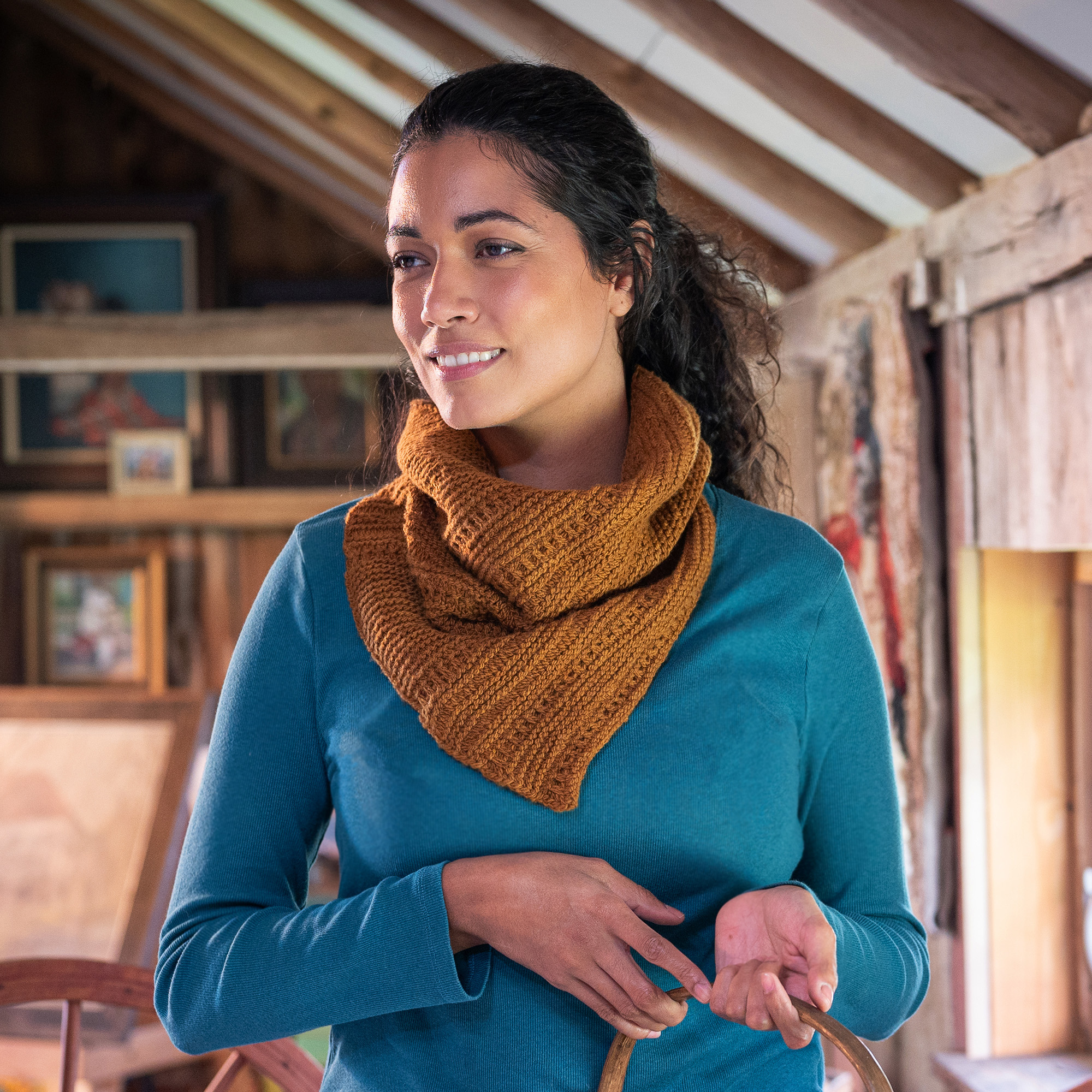
A richly textured accessory relies on techniques that are easy to execute. Enjoy the engaging knitting experience, embracing the feel of the yarn and allowing its wooly beauty to shine.
The cowl is knitted on the bias with a structured selvedge edge, then seamed to create a cowl that’s easy to wear and style. A garter-stitch base with slip-stitch panels and dropped stitches creates a light and cozy combination that is perfect for three-season wear.
MATERIALS
Yarn Mountain Meadow Wool Jackson DK (100% Mountain Merino; 255 yd [233 m]/100 g; DK weight); Sorrel, 400 yd.
Needles Size 6 (4mm). Adjust needle size if necessary to obtain the correct gauge.
Notions Tapestry needle; blocking pins.
Gauge 21 sts and 31 rows = 4" (10 cm) in garter st, blocked.
Finished Size Neck opening circumference 24" (61 cm), side seam height 9" (23 cm), length from neck edge to tip of lower point 20" (51 cm).
Tamy Gore became a knitwear designer through an unconventional route, having no background in the arts, design, or textiles. She has been designing since 2016 and now designs full-time from her home in New Jersey.
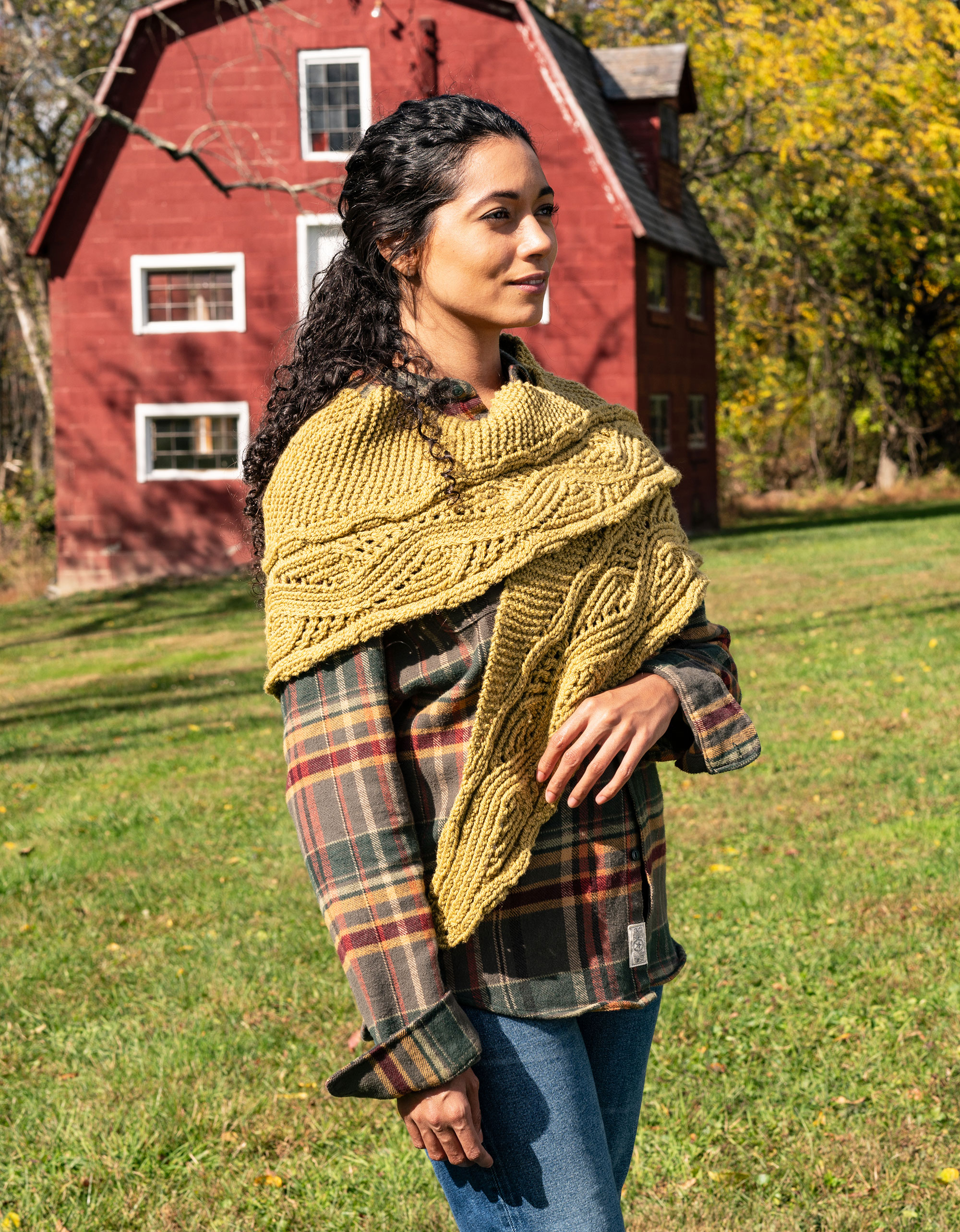
Snakes abound in mythology, from the White Snake of the Brothers Grimm to Scandinavian, Asian, and Australian stories. Sometimes sinister, sometimes helpful, and sometimes princes in disguise, serpents often signify transformation, power, and triumph over fear. This crescent-shaped wrap is worked from end to end and combines a serpentine lace border with a garter-stitch panel of graduated width. It is tapered at head and tail with increases and decreases worked into the lace pattern; the head of the snake is visible at one end and the tail at the other. Imagine the serpent in this design as a guardian, wrapped protectively around the wearer.
MATERIALS
Yarn Stone Wool Corriedale (100% Corriedale wool; 165 yd [150 m]/113 g; Aran weight), colorway Rye 01, 3 skeins.
Needles Size 8 (5 mm). Adjust needle size if necessary to obtain the correct gauge.
Notions Markers (m); cable needle (cn); tapestry needle.
Gauge 18 sts and 27 rows = 4" in garter st; 27 sts of Main chart = 5" wide.
Finished Size 13" deep and 62" wide.
Visit farmfiberknits.com/abbreviations for terms you don’t know.
NOTE
This wrap is worked sideways from the head to the tail.
ANGELA HAHN has a special fondness for Jörmungandr, the Midgard Serpent: according to Norse mythology, he is long enough to surround the Earth and grasp his own tail. Angela was a small-animal veterinarian for many years and included among her patients a few snakes. More of her patterns can be found on her website, knititude.com.
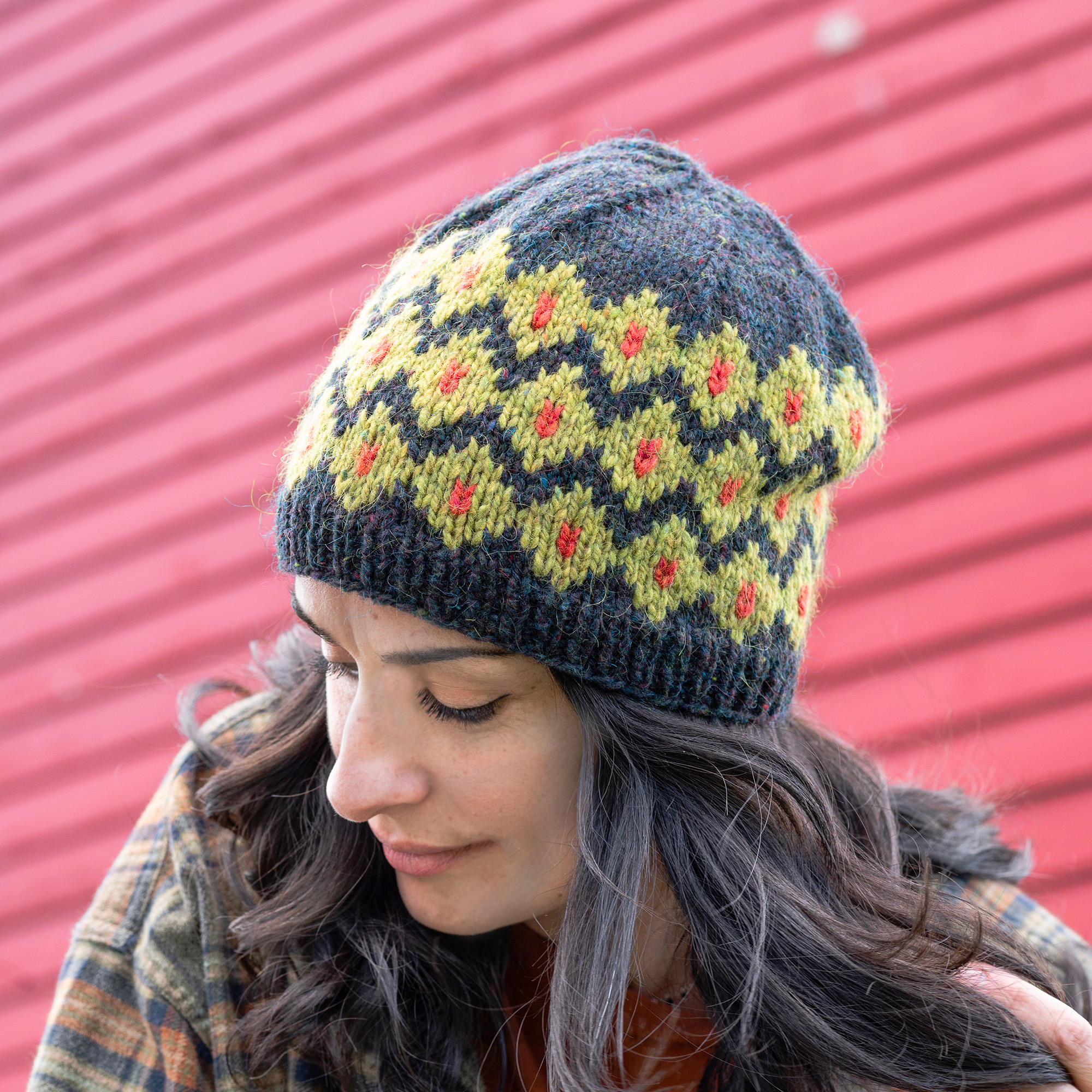
The beautiful banded rugs of Navajo weavers inspired this design. Banded rugs are known for their stripes and repeats of simple designs. I appreciate the simplicity of the stripes and repeating motifs, as other rugs can be very busy and full of complicated patterns—but no less beautiful! The yarn used in these weavings is often dyed with vegetal (plant) dyes and is often full of yellows and natural wool colors. I wove a few banded rugs and found them to be quite challenging to complete. Keeping track of each shape in the row can sometimes be confusing. I corrected mistakes often as I learned this process. In the end, I appreciated the flow of the bands as they repeated themselves throughout the rug.
Diamonds in Navajo weaving can mean different things, but I like the idea of them representing the land that is Navajo country. There are four mountains that surround the Navajo Nation, one in each cardinal direction, which can be seen as a diamond shape. I think of these diamonds as a way to remind ourselves and others that there is a homeland for the Navajo people that is very important (the repeating patterns emphasize that), and this homeland still exists today. This land is also where my heart is, as I love my homeland and like to create designs that remind me of where I come from.
I designed this hat keeping all of these things in mind and represented them visually. The diamonds are symmetrical around the hat, like most Navajo banded rugs. The colors are highly contrasting to help bring the diamonds out. I also enjoyed the simplicity of creating this design with one single motif.
MATERIALS
Yarn Peace Fleece Worsted Weight (50% Navajo Rambouillet, 30% domestic fine wool, 20% Mohair; 200 yd [183 m]/4 oz [113 g]); Sakhalin Salmon (MC), Bonnie Blue Gap (CC1), and Lily Pad (CC2), 1 skein each. Note: This is enough yarn to make 3 hats if you rotate the colors around. You may also make this hat with two colors and use the first color in place of the third.
Needles Size 6 (4.0 mm) and size 7 (4.5 mm) 16" circular (cir); size 7 (4.5 mm) dpn(s) or long cir needles for magic loop. Adjust needle size if necessary to obtain the correct gauge.
Notions Marker (m); 11 markers of a different style or color for pattern repeats (optional); tapestry needle.
Gauge 19 sts and 23 rnds = about 4" (10 cm) in pattern, blocked. 20 sts and 24 rnds = 4" (10 cm) in St st.
Finished Size 20" (51 cm) circumference and 9" (23 cm) tall.
Tressa Weidenaar is a Navajo knitwear designer and lives in Gallup, New Mexico, with her husband and two children. She knits, weaves, and creates with whatever materials are available. She has had designs published in Taproot Magazine, Making GIFTS, and PomPom Quarterly. She can be found on Instagram @tsinbikee and Ravelry as Tsinbikeeknits.
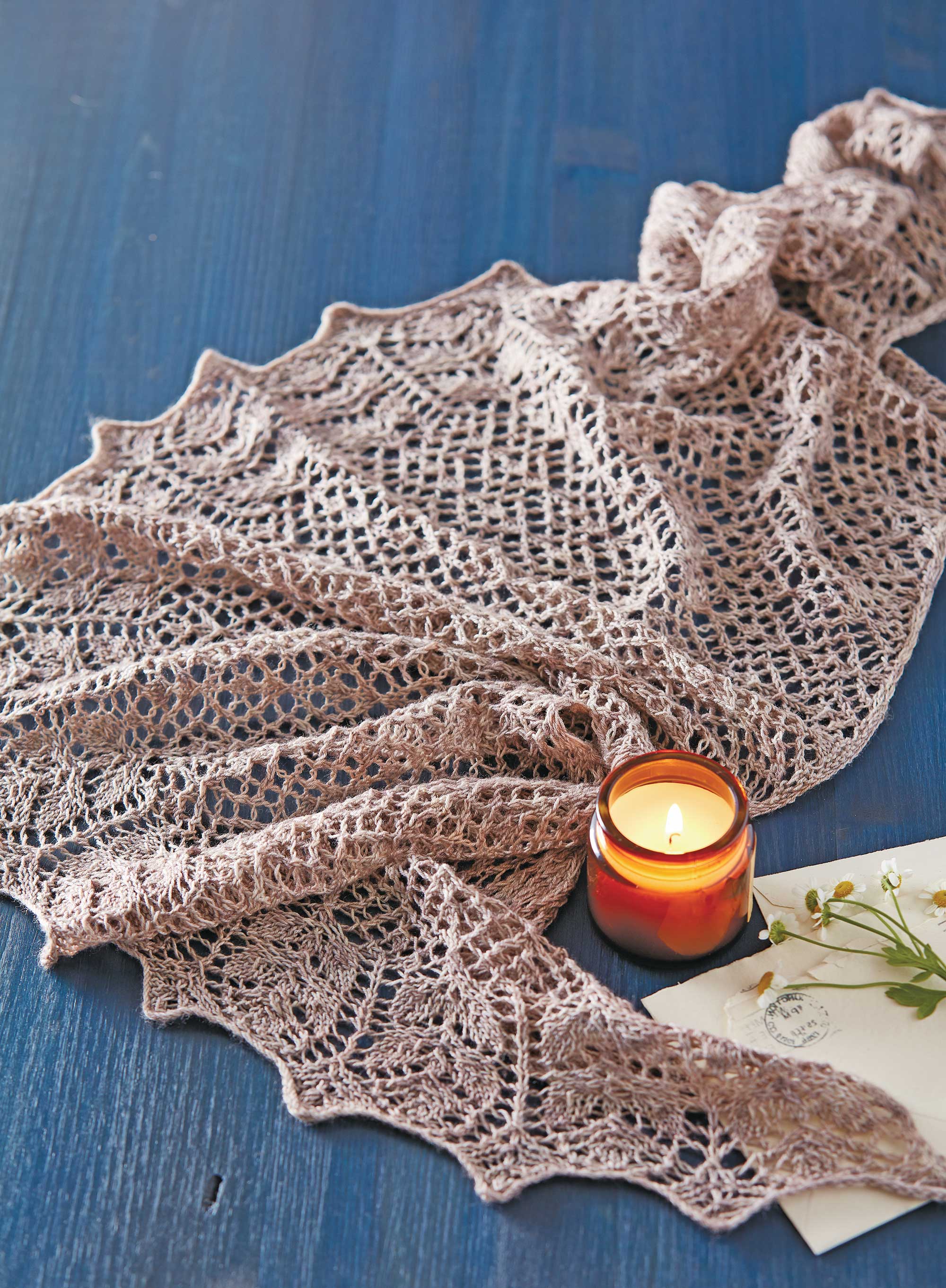
For this project, the designer wanted to create a lace-bordered shawl in a wide crescent shape, but with a lace pattern in the body instead of the solid fabrics shown in many patterns. Additionally, she wanted the construction to be a single piece worked in one direction to make it suitable for a gradient-dyed yarn.
Carolyn discovered the pattern A Veil: Knitted in an Open Diamond Pattern, with Vine Leaf Pattern Border in Weldon’s Practical Knitter, Fifteenth Series, included in Volume 5 of Weldon’s Practical Needlework. The original pattern is a rectangular shape, so she modified the shaping, charted the pattern, and added a decrease chart to create the desired crescent shape.
The silk-blend laceweight yarn shown produces a very light shawl with a nice drape. It uses only about 400 yards (365.8 m) of yarn and could easily be adapted for fingering-weight yarn with the adjustments suggested in the instructions.
MATERIALS
* Hazel Knits Filigree Silk, 50% merino/50% silk yarn, laceweight, 800 yard (731.5 m)/100 gram (3. oz) skein, 1 skein of White Winged Dove
* Needles, size 6 (4 mm), circular 32 inches (80 cm) or longer to accommodate the large number of sts
* Stitch markers
Finished size: About 58 inches (147 cm) wide by 16 inches (41 cm) deep, after blocking
Gauge: 24 sts and 30 rows = 4 inches (10.2 cm) in St st; one 12-st rep from Rows 3–14 of the Border Chart measures about 2½ inches (6 cm) wide, after blocking; exact gauge is not critical for the success of this project
Because her family was traditional, in that all the women did needlework, Carolyn Wyborny has been crocheting, knitting, and tatting since she was very young. She works as a software engineer for a large high-tech company but spends most of her free time coding up knitting and crochet designs. She lives west of Portland, Oregon, with her husband, two children, and several pets.
For this project, the designer wanted to create a lace-bordered shawl in a wide crescent shape, but with a lace pattern in the body instead of the solid fabrics shown in many patterns. Additionally, she wanted the construction to be a single piece worked in one direction to make it suitable for a gradient-dyed yarn.
Carolyn discovered the pattern A Veil: Knitted in an Open Diamond Pattern, with Vine Leaf Pattern Border in Weldon’s Practical Knitter, Fifteenth Series, included in Volume 5 of Weldon’s Practical Needlework. The original pattern is a rectangular shape, so she modified the shaping, charted the pattern, and added a decrease chart to create the desired crescent shape.
The silk-blend laceweight yarn shown produces a very light shawl with a nice drape. It uses only about 400 yards (365.8 m) of yarn and could easily be adapted for fingering-weight yarn with the adjustments suggested in the instructions.
MATERIALS
* Hazel Knits Filigree Silk, 50% merino/50% silk yarn, laceweight, 800 yard (731.5 m)/100 gram (3. oz) skein, 1 skein of White Winged Dove
* Needles, size 6 (4 mm), circular 32 inches (80 cm) or longer to accommodate the large number of sts
* Stitch markers
Finished size: About 58 inches (147 cm) wide by 16 inches (41 cm) deep, after blocking
Gauge: 24 sts and 30 rows = 4 inches (10.2 cm) in St st; one 12-st rep from Rows 3–14 of the Border Chart measures about 2½ inches (6 cm) wide, after blocking; exact gauge is not critical for the success of this project
Because her family was traditional, in that all the women did needlework, Carolyn Wyborny has been crocheting, knitting, and tatting since she was very young. She works as a software engineer for a large high-tech company but spends most of her free time coding up knitting and crochet designs. She lives west of Portland, Oregon, with her husband, two children, and several pets.

Inspired by her love of fiber and craft, custom weaver and former shepherd Lilly Marsh decided to pursue a PhD. Instead of pursuing an art degree, she found herself in American Studies, studying Elizabeth Zimmermann’s influence on knitting and the community of knitters. In this bonus episode for Farm & Fiber Knits subscribers, Lilly shares how a love of fiber has brought her closer to fellow artists.

Inspired by a gift of wool-cotton yarn to make a roomy tunic-length pullover, Amy Tyler used a fancy zigzag stitch on the front and back to separate stockinette and reverse stockinette halves. Following advice from Deborah Newton, she knitted the yarn at a looser gauge than normal to allow plenty of drape, creating a top you’ll reach for from autumn’s first frost to spring’s last chill.
MATERIALS
Yarn Madelinetosh Wool + Cotton (50% superwash Merino wool, 50% pima cotton; 219 yd [200 m]/3½ oz [100 g]; DK weight); Ceremony, 5 (5, 5, 6) (6, 7, 7, 8) skeins.
Needles Size 6 (4.00 mm) at least 24" (60 cm)for body and sleeves. Size 5 (3.75 mm) 16" or 20" (40 or 50 cm) circular (cir) needle for neck edge. Adjust needle size if necessary to obtain the correct gauge.
Notions Markers (m); stitch holders; scrap yarn or removable markers; tapestry needle.
Gauge 19½ sts and 26 rows = about 4" (10 cm) in St st using larger needles.
Finished Size 37 (40, 43½, 47) (51, 55, 60, 65)" (94 [101.5, 110.5, 119.5] [129.5, 139.5, 152.5, 165] cm) chest circumference. Tunic shown measures 47" (119.5 cm), worn with 11" (28 cm) ease.
NOTES
* The Zig Zag pattern can be worked from charts or written instructions.
* The tunic is worked flat in pieces from the bottom up and seamed.
* The two largest sizes have the widest upper bodies, so their sleeves are shorter to prevent the overall wingspan of the garment from becoming too wide.
* For instructions on working the Sloped Bind-off, see purlsoho.com/create/sloped-bind-off.
* The larger sizes have deeper armholes, so their lower bodies are shorter to prevent the overall garment length from becoming too long.
* Avoid binding off tightly across the sleeve tops.
* The lower edges of the body and sleeves will roll gently to the knit side of the fabric after blocking.
Amy Tyler lives in northern lower Michigan, where knitted items of all warmths and thicknesses come in handy. When she’s not petting her dog, she knits, spins, writes, and teaches. Her website is stonesockfibers.com.